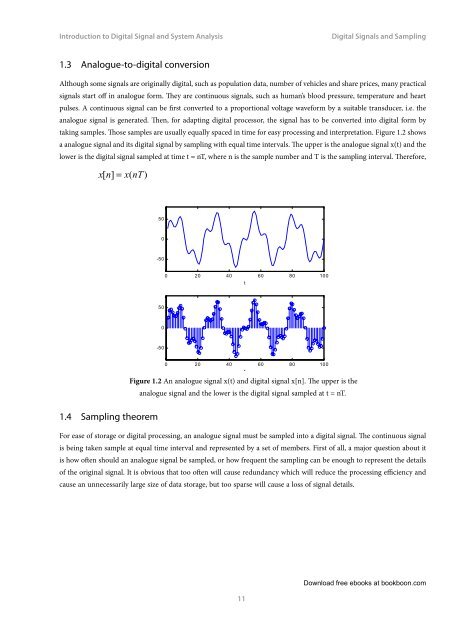Introduction to Digital Signal and System Analysis - Tutorsindia
Introduction to Digital Signal and System Analysis - Tutorsindia
Introduction to Digital Signal and System Analysis - Tutorsindia
Create successful ePaper yourself
Turn your PDF publications into a flip-book with our unique Google optimized e-Paper software.
<strong>Introduction</strong> <strong>to</strong> <strong>Digital</strong> <strong>Signal</strong> <strong>and</strong> <strong>System</strong> <strong>Analysis</strong><br />
<strong>Digital</strong> <strong>Signal</strong>s <strong>and</strong> Sampling<br />
1.3 Analogue-<strong>to</strong>-digital conversion<br />
Although some signals are originally digital, such as population data, number of vehicles <strong>and</strong> share prices, many practical<br />
signals start off in analogue form. They are continuous signals, such as human’s blood pressure, temperature <strong>and</strong> heart<br />
pulses. A continuous signal can be first converted <strong>to</strong> a proportional voltage waveform by a suitable transducer, i.e. the<br />
analogue signal is generated. Then, for adapting digital processor, the signal has <strong>to</strong> be converted in<strong>to</strong> digital form by<br />
taking samples. Those samples are usually equally spaced in time for easy processing <strong>and</strong> interpretation. Figure 1.2 shows<br />
a analogue signal <strong>and</strong> its digital signal by sampling with equal time intervals. The upper is the analogue signal x(t) <strong>and</strong> the<br />
lower is the digital signal sampled at time t = nT, where n is the sample number <strong>and</strong> T is the sampling interval. Therefore,<br />
x [ n]<br />
= x(<br />
nT)<br />
50<br />
0<br />
-50<br />
0 20 40 60 80 100<br />
t<br />
50<br />
0<br />
-50<br />
0 20 40 60 80 100<br />
t<br />
Figure 1.2 An analogue signal x(t) <strong>and</strong> digital signal x[n]. The upper is the<br />
analogue signal <strong>and</strong> the lower is the digital signal sampled at t = nT.<br />
1.4 Sampling theorem<br />
For ease of s<strong>to</strong>rage or digital processing, an analogue signal must be sampled in<strong>to</strong> a digital signal. The continuous signal<br />
is being taken sample at equal time interval <strong>and</strong> represented by a set of members. First of all, a major question about it<br />
is how often should an analogue signal be sampled, or how frequent the sampling can be enough <strong>to</strong> represent the details<br />
of the original signal. It is obvious that <strong>to</strong>o often will cause redundancy which will reduce the processing efficiency <strong>and</strong><br />
cause an unnecessarily large size of data s<strong>to</strong>rage, but <strong>to</strong>o sparse will cause a loss of signal details.<br />
11<br />
Download free ebooks at bookboon.com
















